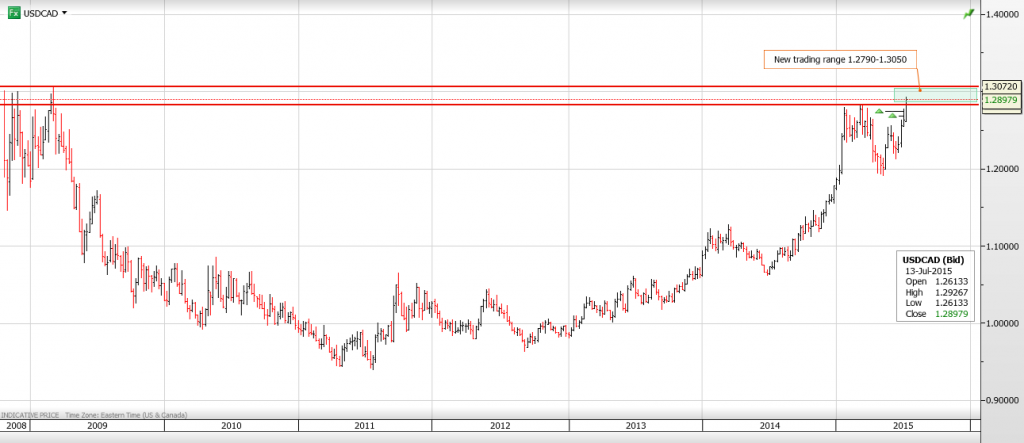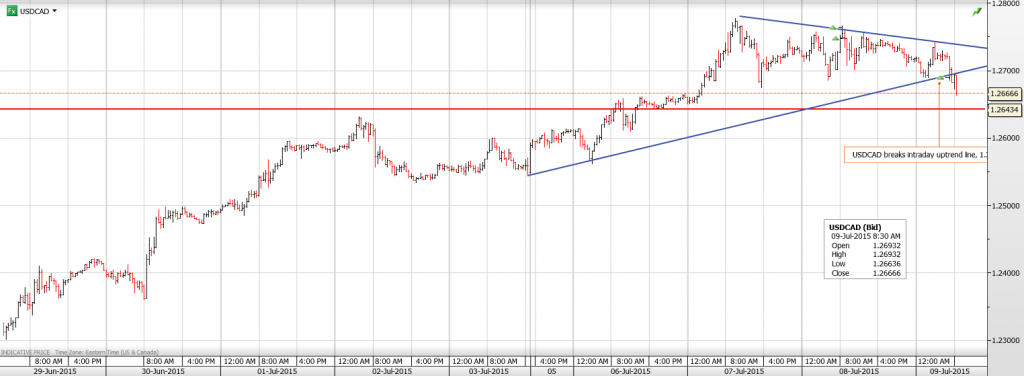Currency
The Bank of Canada cut the overnight target rate to 0.5% and the Loonie lost over a cent in a second. There were many predictions of a rate cut although many lacked conviction which was probably why USDCAD reacted like the move was a surprise. The statement was very doveish as well, noting that “real GDP has likely contracted modestly in the first half”. This morning’s Manufacturing Sales data was also weak.
USDCAD is also being supported by the prospect of lower oil prices due to the Iran nuclear deal as well as the on-going slowdown in China. Janet Yellen’s testimony to Congress this morning revealed that the Fed is still on track to hike rates in 2015 providing support to the US dollar against the majors.
It was a fairly quiet overnight session. Slightly better than expected Chinese GDP data helped give AUDUSD a short lived boost until further China equity market declines erased any positive sentiment. The Bank of Japan left policy unchanged although the governor remarks were positive.
Going forward, assessment of Janet Yellen’s Congressional testimony and ongoing questions surrounding Greece and the Iran nuclear deal should keep the US dollar bid against the majors and USDCAD as well.
Technical Outlook
The intraday technicals are bullish while trading above the 1.2780-1.2820 level looking for a test of 1.3050, although 1.3000 may prove sticky, just because it is a “round number”. The steepness of today’s move has left a huge gap between 1.2790 and 1.2900 which will get back-filled.
Today’s Range 1.2840-1.2930
Chart: USDCAD Weekly with new trading range (green box)

USDCAD Overnight Range 1.2717-1.2802
News that Iran signed a nuclear deal with the US, UK, Germany, France, Russia and China sent oil prices lower and USDCAD higher in overnight trading. The Loonie looked like it had one wing in the grave when New York traders started their day. That wasn’t to be. A bout of profit taking in WTI oil lifted the price from $50.17 to $52.15 which helped to cap USDCAD gains. Then came the release of another disappointing US retail Sales number (down 0.3% vs. forecast for a gain of 0.3%) which sent USDCAD tumbling through support at 1.2760, triggering stop losses and reaching a low 1.2717. It has since bounced back and is currently at 1.2755.
The weak US retail sales number may temper any hawkish inclinations in Fed Chair Yellen’s testimony to Congress, tomorrow.
It was a lively overnight session with AUDUSD and USDJPY both climbing in Asia. Aussie was bid following an improvement in NAB business conditions while JPY was sold ahead of the two day BoJ meeting and Fed Chair Yellen’s testimony to Congress, tomorrow. China equity markets retreated which raised questions about the effectiveness of the recent official intervention.
Cable caught a bid in Europe after Bank of England governor, Mark Carney, used “interest rate hike” in a sentence alluding to a “rate hike getting closer” in testimony to the UK Commons Treasury Panel. GBPUSD jumped 0.0150 points in a flash.
The Greek/EU debt deal is only a deal if PM Tsipras can convince the Greek parliament to pass the deal into law and comply with EU demands by tomorrow. That is far from a sure thing, especially since the media has be swamped with reports that Tsipras negotiated a far worse deal than what was previously offered.
Technical Outlook
The intraday technicals are modestly bearish following the failure to extend gains above 1.2800 and the subsequent retracement below 1.2760 which implies intraday consolidation in a 1.2710-1.2800 range. However, the uptrend remains intact above 1.2690-1.2700 which is looking for a break of resistance in the 1.2820-50 area to extend gains to 1.3050. For today, USD Support is at 1.2730 and 1.2690. Resistance is at 1.2790 and 1.2820
Today’s Range 1.2720-1.2790
Chart: USDCAD 4 hour Larger Chart

Recent Chinese trade deals and the formation of the Asian Infrastructure Investment Bank have given the dollar a run for its money.
Today’s infographic shows countries that have bypassed the dollar in bilateral trade agreements.
View a larger version of the Dollar Slowly Losing its Status & more analysis HERE

 The Austrian School of economics has a concept called a “crack-up boom” in which a critical mass of people conclude that their government is actively trying to devalue its currency.
The Austrian School of economics has a concept called a “crack-up boom” in which a critical mass of people conclude that their government is actively trying to devalue its currency.
Consumers respond by front-running the government, spending their paychecks immediately in order to convert their soon-to-be-less-valuable money into real things. Merchants, not happy about the sudden influx of suspect currency (and sensing the panic of their customers) hold out for ever-higher prices, causing inflation to spike. But it’s a special kind of inflation, driven not by a sudden increase in the money supply but by collapsing confidence among holders of the currency.
In a very short time, so goes the theory, the supply of stuff available for purchase dries up, prices hyperinflate, and the economy collapses.
Welcome, in other words, to Greece:
Greeks spend in droves, afraid of losing savings to a bailout
(CNBC) – Business has been so brisk in the giant Kotsovolos appliance and electronics store in this upper-middle-class suburb of Athens that you might think a sale was on.
But, no. It is panic buying, those who work here say. Increasingly concerned that greater economic trouble lies ahead of them, and limited in how much cash they can take out of banks, Greeks have been using their debit cards to buy ovens, refrigerators, dishwashers — anything tangible that can hold its value in troubled times.
“We have sold so much,” said Despina Drisi, who has worked in the store for 12 years. “We even sold display models. People have been pulling at my sleeves. We’re spacing things out now to cover the holes on the shelves.
To the casual observer, the bustle of everyday life looks unchanged here. Greeks, many of whom long ago traded in their cars for cheaper motor scooters, clog the streets at rush hour on their way to and from work. Tourists pack the Acropolis. Friends meet, greet and sit in cafes, looking for shady spots against the heat.
But beneath the surface, Greeks are struggling with growing fear, the strange ramifications of closed banks and the mounting potential for much worse. They could face the unknown consequences of being pushed out of the eurozone within the next week if Greece and its creditors cannot come to an agreement.
Some are watching television and checking their smartphones constantly. Others refuse to follow what is going on in Brussels at all. But either way, many are doing what they can to protect themselves financially, buying appliances and jewelry or even prepaying their taxes so they will have taken care of one financial obligation if they end up losing some of their savings to a bank failure, as happened to depositors in Cyprusunder a bank rescue plan there in 2013.
“Panicked doesn’t begin to describe how people feel,” said Antonis Mouzakis, an Athens accountant. “I have a huge number of customers wanting to file their taxes right here, right now, to have the tax calculated and paid instantly before a possible haircut. Even if the tax is 40 to 50 thousand euros, they pay it off in one go.”
A Greek jeweler, George Papalexis, said a customer had approached him on Wednesday wanting to buy a million euros — about $1.1 million — worth of merchandise. But Mr. Papalexis, the chief operating officer of Zolotas, said he had refused because he was more comfortable holding on to the jewels than having money in Greek banks.
“I can’t believe that there I was, turning away a million-dollar offer,” he said. “But I had to turn down the deal. It’s a measure of the risk we face.”
Mr. Mouzakis said that many companies were also trying to settle their debts quickly, not wanting to owe money if their deposits are hit in a deal to rescue Greek banks. Others do not want to accept payments for the same reason. When banks in Cyprus had to be bailed out in 2013, depositors with more than €100,000 lost about 40 percent of their money.
A contractor at a Greek energy company, who spoke on the condition of anonymity, said his firm had paid all its taxes for the year last week to whittle down the funds that could be subject to a deposit tax.
“I’m even thinking about buying a car, although I don’t need one, to get my cash balance lower,” he said. “People want their money in physical assets, not in the bank.”
But some who are unlikely to be troubled by losing a percentage of their bank deposits are spending, too. Vassilis Bekiaris, 29, said he knew two brothers who had gone on what was probably an ill-advised spending spree, fearing a cut to their savings. One who had just €1,000 in his account bought an iPhone. The other had €10,000 euros but, thinking he could lose 20 percent, bought €2,000 worth of clothes. “All they managed to do was prop up the economy a bit,” Mr. Bekiaris said.
While pensioners and others in need of cash struggled, some employers who were behind in paying their employees surprised them by digging into their safes and producing cash rather than risk losing money to the terms of a bank bailout.
A few companies, prepared for the bank closings, were ready to pay cash to their grateful employees. The family-owned Petsas group, which manufactures a range of products from biodiesel to cotton clothing, paid all of its workers, about 130 people, in cash.
When Greeks start clamoring to pre-pay their taxes, you know the end is near.
But viewed through a Keynesian rather than Austrian lens, this process actually looks kind of positive, like really effective stimulus. The Greeks appear to have discovered the secret to convincing an over-indebted people to keep borrowing and spending: Just telegraph the destruction of their savings and watch the little folks consume.
In an era when new and wild economic theories are being tested on a weekly basis, Greece is perhaps the most interesting laboratory of all. If this sudden burst of consumption and tax compliance results in “growth” and “a balanced budget” then don’t be surprised if the people running the eurozone, Japan and maybe the US come to the comical but from their point of view logical conclusion that far from screwing up, Germany actually did something right in Greece. And that maybe the rest of the world should pre-announce capital controls and bank bail-ins to get their citizens off their butts and into the mall.
Which, when you think about it, might be exactly what the war on cash is setting up.

USDCAD Overnight Range 1.2690-1.2745
This morning’s higher US Jobless claims data (297k vs. forecast of 285K) and modestly better Canadian Housing data (which is expected in June) has taken the wind out of the sails for recent USDCAD bulls. The break of intraday support at 1.2690 sets up a test of 1.2660 support which we may see today.
USDCAD traded in a fairly narrow range overnight. In Asia, it hovered around the New York close (1.2730) but that wasn’t the case in early European trading. USDCAD headed lower to just below 1.2700 before bouncing, in part due to the rebound in China equity markets.
It was a fairly active session overnight, beginning in Asia. The much-better-than-expected Australian employment data gave AUDUSD a brief boost prior to renewed weakness in Chinese equity markets, crushing that rally. The China CSI 300 dropped initially and then quickly reversed, posting a 5.7% gain on the day. There may have been some “official” support for the rally but no one is saying.
European traders took their cue from the Asian markets and sold US dollars, helping to drive EURUSD to 1.1125. That momentum didn’t last. A number of ECB officials sounded pessimistic on Greece developments and the earlier gains were erased.
Yesterday’s release of the FOMC minutes proved to be a non-event although some tried to make a doveish case because the Committee acknowledged risks from China and Greece. It would have bee news if they didn’t acknowledge the risks.
Technical Outlook
The intraday technicals are modestly bearish following the failure to extend gains above the 1.2750-70 area todays move below 1.2690 likely to extend to the 1.2640-60 area. A break below 1.2640 would indicate that a short term top is in place at 1.2760 and suggest further downside to 1.2530. A move above 1.2780 will extend gains to the 1.2820-50 zone.
Today’s Range 1.2660-1.2730
Chart: USDCAD 30 minute with break of uptrend shown Larger Chart
















